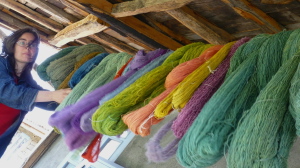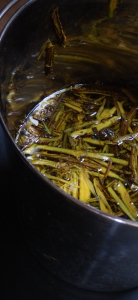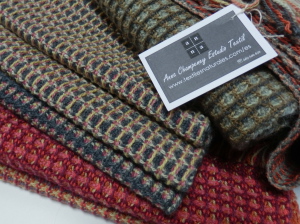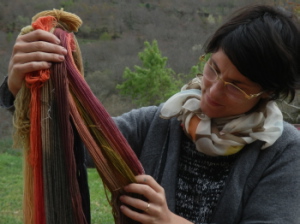Eco-friendly fabrics from Spain
Barberry bark, madder root, dried cochineal and walnut husks are all sources of natural colour used to create the textiles at the weave studio of textile designer Anna Champeney in north Spain. The studio´s collections include limited edition double-weave linens, double-sided scarves in richly-coloured silk and wool, and a range of linen and wool textiles for interiors, including cushions, storage bags and decorative wall-dividers. The designs vary with each collection but what unites all these textiles is the rich and harmonious use of natural colour.
The reality is that the colours produced by natural dyes are different to most synthetic dyes today because the complex formulas of natural plant dyes – a single plant may contain several dyes which combine to produce a particularly rich or subtle colour – are usually too expensive to produce in the context of industrial textile production.
This makes natural dyes the ideal choice for certain designers and specialist artisans who seek to produce a high-end product and who also care about the way that textiles are made today and the impact on the natural world.
“I started working with natural dyes as it seemed the obvious choice given the location of the textile studio in rural north Spain where there was an abundance of natural dyestuffs. Of course, I was also interested in making a more organic or natural product. For me this meant sourcing dyestuffs as locally as possible, using processes which were efficient, with little waste, and avoiding chrome as a fixative ” commented Champeney.

Drying yarns dyed with lichen, gorse, indigo and madder at Anna Champeney Estudio Textil in north Spain
The quality of the colours produced was also a factor. “As a textile designer and craft weaver you often find yourself limited by the commercial colour ranges. By dyeing my own colours I can achieve incredibly varied and subtle colour blends which lend a special quality to the finished textiles. This gives me a certain freedom which industrial designers simply do not have”.
Marta Bahillo – Spanish knit designer – opts for natural dyes
Marta Bahillo, a young Spanish knit designer is also moving in this direction which was why she decided to spend time at AC Estudio Texil for some intensive colour tuition.
Working with natural dyes for the first time was nothing short of a revelation for this designer, whose working practice up until now always involved off-the-peg synthetically-coloured yarns. “I really feel the course has changed me because I see colour in a different way now”, commented Bahillo, “I can see subtle changes in tone which I didn´t notice before”. Moreover, Bahillo was particularly struck by the sheer variety and richness of the colours obtained using natural dyes. In the context of her work as a knit designer Bahillo sees definite advantages in being able to have a greater control over the final result. Working directly with the dyes gives her a far greater creative involvement in the process, leading her to comment “As a textile designer I feel more confident than before”.
Natural Dyes and Fashion
But what about the dictates of fashion which result in certain colours dominating the market every year. Is it important for these new designers to look at colour forecasts for fashion? Champeney thinks not. “My clients tend to have a confidence in their own sense of style and colour and choose colourways which suit them rather than to follow the dictates of the fashion industry. They may combine my textiles with clothing from branded fashion but their style is definitely an individual style which is unique to them. The challenge for independent designers or makers not to follow fashion but to make textiles which are so distinctive and beautiful that each piece becomes a personal classic in its own right”.
More information:
- Inquiries about Anna Champeney Estudio Textil´s limited edition textile collections – please contact the studio.
- Textilesnaturales hopes to feature Marta Bahillo again in a future feature.








